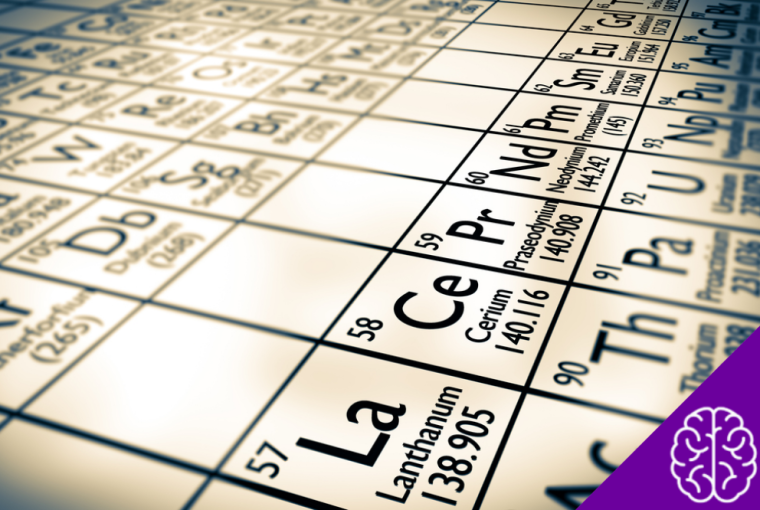Rare earth elements have become central to discussions about technology, sustainability, and geopolitics. These materials are essential for everything from smartphones to electric vehicles, and the global race to secure a stable supply is heating up. With one of the world’s largest reserves, Brazil is drawing significant interest from powers like the United States, Australia, and Canada.
This article in the Insight Factory will explain what makes these raw materials so valuable, where they are found, and why countries are competing for access to them. You’ll gain a clear understanding of the critical role rare earths play in our modern world and the strategic importance they hold for the future.
What Are Rare Earth Elements?
Despite their name, rare earth elements (REEs) are not exceptionally scarce. The term was coined in the 19th century when these elements were found in uncommon minerals that were difficult to isolate.
In reality, they are relatively well-distributed across the Earth’s crust. The “rare” part of the name comes from the fact that they are typically found in low concentrations and are often mixed with other minerals, making their extraction a complex and expensive process.
Rare earths are a group of 17 chemical elements from the periodic table. This group includes scandium (Sc), yttrium (Y), and the 15 lanthanide series elements, such as lanthanum (La), cerium (Ce), and neodymium (Nd). They share similar chemical properties, which is why they are classified together.
The 17 Rare Earth Elements
The group of rare earths is composed of 17 chemical elements that share similar properties, particularly related to electrical conductivity, magnetism, and fluorescence.
They are divided into three subgroups: the lanthanides, scandium, and yttrium. Here are the 17 elements:
- Lanthanum (La)
- Cerium (Ce)
- Praseodymium (Pr)
- Neodymium (Nd)
- Promethium (Pm)
- Samarium (Sm)
- Europium (Eu)
- Gadolinium (Gd)
- Terbium (Tb)
- Dysprosium (Dy)
- Holmium (Ho)
- Erbium (Er)
- Tulium (Tm)
- Ytterbium (Yb)
- Lutetium (Lu)
- Scandium (Sc)
- Yttrium (Y)
What Are Rare Earths Used For?
Rare earths are essential for the operation of many technologies we use daily. These elements possess special properties like strong magnetism, fluorescence, and high electrical conductivity, making them indispensable in various applications.
Even when used in small quantities, they have a massive impact on the performance of the products they are in.
You can find them in almost everything. In smartphones, they help with screen functionality, vibration, and even the cameras.
In televisions and monitors, especially LED and plasma screens, they are used to enhance brightness and color fidelity. They are also found in LED and fluorescent lamps due to their ability to emit light efficiently.
In the transportation sector, rare earths are fundamental to the advancement of electric and hybrid vehicles.
Components like motors and batteries use high-performance magnets made with elements such as neodymium and dysprosium, making these systems lighter and more powerful.
Similarly, wind turbines use these magnets to generate energy more efficiently in a compact and quiet manner.
Furthermore, they play a significant role in the healthcare field, appearing in MRI machines, surgical lasers, and other advanced medical equipment.
In defense and aerospace systems, they are indispensable for radars, sensors, guided missiles, satellite communication equipment, and navigation technologies.
The main advantage of rare earths is their ability to deliver high performance with few, if any, viable alternatives that can match their level of efficiency.
The World’s Largest Rare Earth Reserves
While the extraction and processing of rare earths require specific technologies and significant environmental care, the size of a country’s reserves is a strategic factor in its global standing.
China overwhelmingly leads the rankings, holding approximately 44 million tons of known reserves. The country not only has the largest quantity but is also the world’s leading producer, controlling a large portion of the entire supply chain.
Following China is Brazil, with an estimated 21 million tons, accounting for about 23% of global reserves, according to the Ministry of Mines and Energy (MME).
Although Brazil’s potential is still largely untapped, the country is positioned to become a major global supplier, driven by the growing demand for clean technologies.
Russia also has a significant presence, with reserves of around 28 million tons. Geopolitics and access to processing technologies influence its market participation, but its resource volume is substantial.
India, with approximately 6.9 million tons, and Australia, with 5.7 million, complete the list of countries with the largest reserves. Australia, in particular, has been investing in more sustainable supply chains and is seen as a stable alternative to the world’s reliance on Chinese production.
Where Are Rare Earths Found in Brazil?
Brazil has immense potential when it comes to rare earths, and several regions are already standing out due to their known reserves and early production efforts. These deposits are primarily located in the North and Center-West regions of the country.
One of the main areas of interest is the Parnaíba Basin, which spans parts of the states of Maranhão, Piauí, and Ceará.
Geological research in this region has shown consistent evidence of minerals containing rare earths. Although exploration is still in its early stages, studies indicate significant extraction potential for the future.
Another key location is the city of Minaçu, in the state of Goiás. This area contains a deposit of ionic clay rare earths, a type of soil where the elements are more easily extracted with lower environmental impact.
This type of deposit is similar to those found in China. Minaçu is the only location outside of Asia that has managed to produce rare earths from ionic clay on a commercial scale, making the area even more relevant internationally.
In addition to these main points, research is being conducted in other regions like the Amazon, Pará, Bahia, and Minas Gerais, which could also become important production areas in the future.
Why is the US Interested in Brazil’s Rare Earths?
The interest of the United States in Brazil’s rare earth elements is driven by strategic, technological, and economic security.
These elements are indispensable for high-tech manufacturing, including military equipment, batteries, turbines, electric vehicles, and semiconductors. Currently, China dominates the global supply, creating a dependency that many countries are eager to reduce.
In this context, Brazil emerges as an attractive alternative. With the world’s second-largest rare earth reserves, the country is seen as a key player in diversifying the global supply of these strategic minerals.
For the United States, forming partnerships with countries like Brazil is a way to guarantee access to these resources, especially in the face of geopolitical tensions or trade restrictions.
This interest is not exclusive to the Americans. Australia and Canada are also active in Brazil, conducting geological research and initiating exploration projects.
These countries share the same goal: to secure stable and reliable sources of rare earths to meet the growing demand for sustainable technologies and to compete in the global technology race.
The Path Forward!
The global demand for rare earth elements is only set to increase as the world transitions to greener technologies and more advanced electronics.
While countries like China currently dominate the market, the vast, untapped reserves in nations like Brazil offer a significant opportunity to diversify the supply chain and reduce geopolitical dependency.
For Brazil, this represents a chance not only to supply raw materials but also to develop its own domestic processing and manufacturing capabilities, creating skilled jobs and adding value to its natural resources.
However, realizing this potential will require substantial investment in infrastructure, technology, research, and sustainable environmental policies.
As the strategic importance of rare earths continues to grow, the world will be watching closely to see how this story unfolds!


